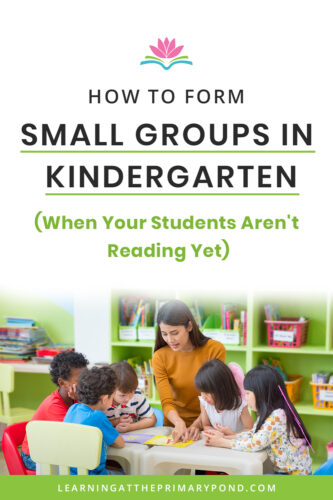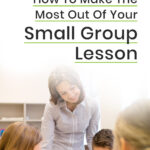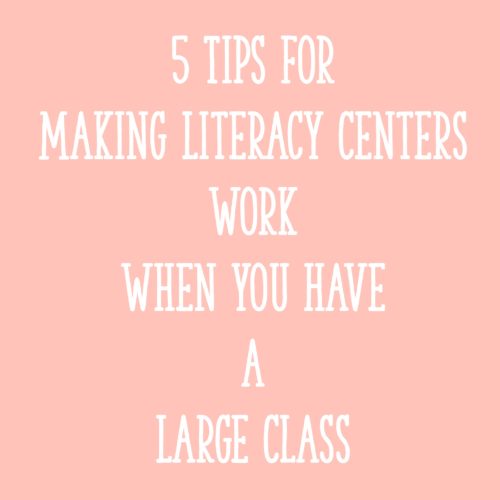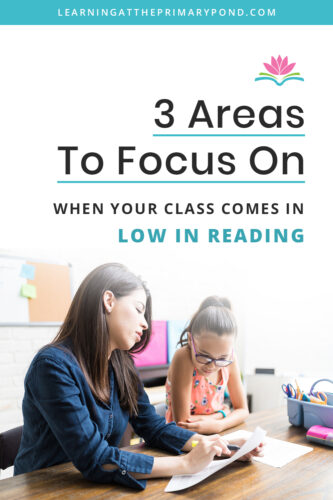There’s a lot of information out there on how to differentiate and create small groups for students who are actually reading… but what about when students haven’t yet started to decode? What’s the best way to group your Kindergarteners before they start reading?
With older students, making groups is a bit clearer. You can look at the phonics skills they’re working on and/or group by reading levels. (Here’s a blog post I wrote entitled “How To Group K-2 Students for Guided Reading” if you want more info on that!)
However, with early Kindergarteners, it’s a little more difficult. You may have students who can already identify most of their letters and sounds, but you also could have a pretty good chunk of students who barely know any of their letters.
Many assessments would just put your entire class under a “pre-reading” category. What do you do with that general label when trying to create multiple small groups?!
In this post, I have a video (and transcript, if you prefer to read) that will help you form small groups with your Kindergarten students who are at that pre-reading level.

Transcript to read:
“Hey, I’m Alison from Learning At The Primary Pond. I’m a literacy specialist. And in this video, I’m going to explain how you can put your kindergarten students into small groups for literacy instruction, even when they’re not quite reading yet. if you haven’t subscribed to my channel (https://www.youtube.com/@learningattheprimarypond) yet, make sure to do that now, and then also hit the little bell so that you don’t miss any of the brand new videos that I post about teaching literacy in K-2. Okay, let’s talk small groups.
We know that small group work has the potential to be really impactful for our students. It’s where we can differentiate and meet kids’ individual needs. And knowing how to group students for that small group work, knowing how to group effectively can really help you maximize that instructional time. However, when it comes to kindergarten students, sometimes it’s just not clear how to put them in small groups. You may not have a reading level or a phonics diagnostic assessment results where you would know these are the patterns they know, and these are the patterns that they don’t know yet, because kindergartners are really just working on those basic pre-reading or early literacy skills.
So if you have ever had trouble figuring out how to put your pre-readers or your kindergarten students at the beginning, maybe even middle of the year into small groups, I would love for you to type the word ‘trouble’ into the comments, just so that other teachers know that they’re not alone in this. It definitely can be tricky and it’s something that personally took me a while to figure out. And I went through some trial and error and different iterations of how I actually did this.
Let’s talk about what data can be helpful to get when you’re thinking about putting your kiddos in small groups. First and foremost, you want to think about phonological awareness. So this is just awareness of the sounds and words, and then there’s phonemic awareness, which is individual or awareness of the individual sounds and words, which is kind of a subset of phonological awareness. So you may have some type of assessment already where you can get info showing if your kids rhyme. Can they hear the individual words in a sentence, break it up? Can they blend and segment syllables? Can they tell you these two words start with the same sound, like sun and sock? Can they match those? Can they even blend sounds or segment? They may not be there yet at the very beginning or even the middle of kindergarten. However, it’s really helpful to have some information on a kiddo’s phonological awareness, because that really serves as the foundation of these pre-reading skills.
Next up, you’re going to want to get some data, which you probably already know, probably already have on letter identification and letter sound knowledge. There are assessments out there where… And you might have to get one for your school where you’re looking to see how many letter sounds or how many letter names the kiddos always can do in a minute. And that’s helpful information for fluency, but when you’re putting them into small groups, you kind of want to know, not just how many letters can they say in a minute, but what letters do they actually know? What letters do they not know yet? How many letters total have they already mastered? So that’s just a simple assessment where you have them identify capital and lower-case letters and then you go back and you do it for letter sounds. Don’t do it in one sitting or have a little bit of a break in between. We might do letter names and then we’ll take a little break and do something else. Then we’ll come back and do letter sounds. But you want to make sure that you have information about that when you’re thinking about putting them into groups.
And then another thing that I think about as kids are getting to that point where maybe they’re beginning to read a little better, or they’re going to be ready to read soon is print concepts. And so that kind of thing is like, can the kids handle the book? Do they know where the cover is? Can they do any left to right print tracking yet? Can they point one to one if they’re pretend reading? Because these things, while they’re not necessarily the foundation of a lot of the pre-reading skills that you’re teaching, they’re still going to become relevant when you present a book to a child and are getting them to try to decode for the first time. So information about their print knowledge is also helpful.
Once you have that data, the phonological awareness, the letter and then print concepts (if you want that), you can pinpoint how you’re going to group your students. And so for me, I always start with letters and sounds. So if you have students who maybe know zero to five letters, you can put them in one group, students who know six to 11 letters, you put them in another group, students knowing 12 to 18 letters, whatever… I don’t know if I got the numbers, but something like that, you can put them in another group. And then if kids know most of their letters already, what you could do is look at which specific letters they know and do not know and group them that way. So different ways to think about it could be number of letters known, could also be which letters are known.
And then once you have those groups set, I do still find it helpful to look at information about their phonological awareness and then their print concepts, because it’s not super common, but you could end up having a kiddo who knows quite a few letters, but maybe their phonological awareness is a little bit lacking or maybe majorly lacking. So you may choose to put that student in a different group because you know that that group is going to focus more on phonological awareness and some of those pre-literacy skills that that child is going to need. So I feel like the basis for making groups is letter knowledge. And then I use the print knowledge and then the phonological awareness info to make any tiny adjustments and just keep that in mind when I’m actually working with them.
Speaking of actually working with the kiddos, we’re not going to go into this in detail, but I do just want to touch on what do we do once they are in small groups? So of course, because we’re working on those early literacy skills, a lot of what we do in small group is phonological awareness and phonics. And I do like to incorporate book reading, but it might look a little bit different from a group of students who is already able to decode. So let’s look a little bit at what that might be like. I’m going to show you a couple of resources and they’re actually all free. I’m going to include the link (https://www.kindergartenliteracyclub.com/k-2-small-group-in-a-snap) in the caption so you can grab this. It’s part of my small group in a snap package that’s actually good for K-2 and has all these different kinds of simpler, small group resources. But anyway, like I said, for those pre-reading small groups, a lot of what we’re doing is learning the letters and phonological awareness. And then with a book, I still like to be building those print concepts so that when they’re at the point that they can decode, they know how to point under the words, how to track left to right. All that good stuff. So we’re kind of simultaneously working on these skills and then eventually we put them together to be able to read and write.
Here is an example, and again, this is free and I’ll include the link in the caption for this, but it’s a book that you can use in different ways. It’s ‘Sid The Cub.’

And for your kiddos that really can’t read at all, this is a great opportunity to do a shared read. And it just goes very quickly, but you read them the words and you could even do an echo read where they each have their own copy of the book. You talk about, “Okay, point to the title. Where’s the picture on this page?” And you can talk about all those print things. And then when it’s time to actually read, you may do the reading and you may say, ‘Okay, put your finger under this word.’ You may even discuss, ‘What letter does this begin with? Do you see any other letters you know?’ Things like that. Then you read ‘Sid’ and then they point and they read Sid. Then you turn the page and then you read ‘den.’
So the pictures tell them the story and you can talk about ‘What did you see in the pictures? What happened in the story?’ With this book, that’s how you could do it for kids that aren’t reading yet. But then when you do have kids that can decode, you can either help them or they can do a little bit of CVC word decoding.
Generally speaking, the way that I do it with these little ones is we don’t go from nothing to ‘Here’s a whole decodable text. You’re going to read all these CVC words.’ No. In the literacy clubs (https://learningattheprimarypond.com/literacy-clubs/) where we provide a lot of kindergarten resources, what we do is we gradually stair-step them in. So they’re starting with a shared read. And then eventually there are books where there’s some high-frequency words and there’s maybe just a couple of CVC words. And then there’s a more challenging level where there’s more CVC words. So we kind of gradually step them into reading, but don’t want to go too far off on a tangent there.
Other things you might do, maybe these pictures are related to the book. And so they could do a beginning sound sort, cut them out, all that good stuff. And then I also have for you in the freebie, all these little phonics and phonological awareness quick checks where they’re different levels for different levels of students. You can see how they’re doing with rhyming, beginning sounds, identifying the first letter in a word like for pencil circling P. So this is something you can also do in small group, because even though you have that initial data, you want to keep finding out how are these kiddos doing? Do I need to make any adjustments, etc.
Again, if you would like these small group resources for free, there’s more than just what I showed you in the pack. Make sure to check out Small Group in a Snap. I will include the link (https://www.kindergartenliteracyclub.com/k-2-small-group-in-a-snap) for that in the caption. And again, it’s totally free, so I would love for you to take advantage of that.
I hope this was helpful. Of course, if you have any questions, leave them below. Appreciate you being here. Don’t forget to hit the like button, subscribe (https://www.youtube.com/@learningattheprimarypond), and I will see you in the next video.”
Conclusion
I hope this provided a bit more clarity on how to group students who are not officially “reading” yet! If you’d like some FREE small group lesson plans and resources, check out my Small Group in a Snap. This freebie has:
- a bundle of 8 small group lesson plans
- the accompanying texts
- supplemental activities
The Small Group in a Snap includes a level for those pre-readers! Check it out by clicking here.
Happy teaching!













